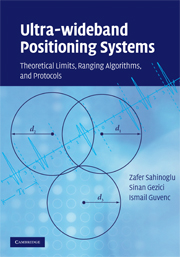Book contents
- Frontmatter
- Contents
- Preface
- 1 Introduction
- 2 Ultra-wideband signals
- 3 Ultra-wideband channel models
- 4 Position estimation techniques
- 5 Time-based ranging via UWB radios
- 6 Ranging protocols
- 7 Special topics in ranging
- 8 Practical considerations for UWB system design
- 9 Recent developments and future research directions
- References
- Index
1 - Introduction
Published online by Cambridge University Press: 23 December 2009
- Frontmatter
- Contents
- Preface
- 1 Introduction
- 2 Ultra-wideband signals
- 3 Ultra-wideband channel models
- 4 Position estimation techniques
- 5 Time-based ranging via UWB radios
- 6 Ranging protocols
- 7 Special topics in ranging
- 8 Practical considerations for UWB system design
- 9 Recent developments and future research directions
- References
- Index
Summary
Wireless communications are becoming an integral part of our daily lives. Satellite communications, cellular networks, wireless local area networks (WLANs), and wireless sensor networks (WSNs) are only a few of the wireless technologies that we use every day. They make our daily lives easier by keeping us connected anywhere, anytime.
Since more and more devices are going wireless every day, it is essential that future wireless technologies can coexist with each other. Ultra-wideband (UWB) is a promising solution to this problem which became popular after the Federal Communications Commission (FCC) in the USA allowed the unlicensed use of UWB devices in February 2002 subject to emission constraints. Due to its unlicensed operation and low-power transmission, UWB can coexist with other wireless devices, and its low-cost, low-power transceiver circuitry makes it a good candidate for short- to medium-range wireless systems such as WSNs and wireless personal area networks (WPANs).
One of the most promising aspects of UWB radios are their potential for high-precision localization. Due to their large bandwidths, UWB receivers can resolve individual multipath components (MPCs); therefore, they are capable of accurately estimating the arrival time of the first signal path. This implies that the distance between a wireless transmitter and a receiver can be accurately determined, yielding high localization accuracy.
Such unique aspects of UWB make it an attractive technology for diverse communications, ranging, and radar applications such as robotics, emergency support, intelligent ambient sensing, health-care, asset tracking, and medical imaging (see Fig. 1.1).
- Type
- Chapter
- Information
- Ultra-wideband Positioning SystemsTheoretical Limits, Ranging Algorithms, and Protocols, pp. 1 - 19Publisher: Cambridge University PressPrint publication year: 2008
- 1
- Cited by



